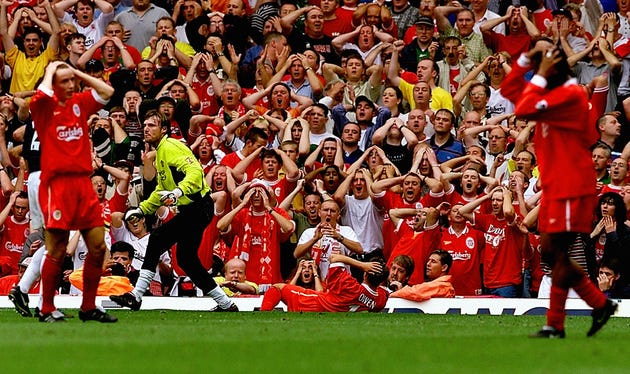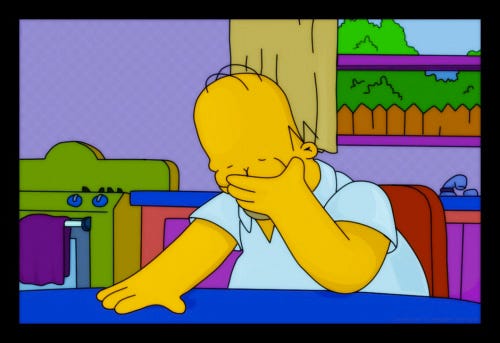On holding one's head
Some use an egg shape; others a cube or block. Some even start with one feature and start building the form out around it until the whole head is encompassed. However, all these involve many chances for error. Only the front view of the head looks like an egg, and even that gives no line of the jawbone. In profile the head is not like an egg. As for the cube, there is no accurate way of setting the head into it. The head is totally unlike a cube from any angle.
– Andrew Loomis, Drawing the Head and Hands (1956)

Michael Owen, his Liverpool teammates and the crowd holding their heads, 1999 (Phil Noble/PA Archive/Press Association Images, via)
It's Mental Health Awareness Week in New Zealand! This is a short ode to holding your head in your hands. My preferred settings in which to hold my head in my hands are while sitting at a desk and while sitting in the shower first thing in the morning. I also like to walk along a street, remember something embarrassing I did ten years ago or ten minutes ago, and then clap my hands to my head. Part of the humanity of the gesture is that it doesn't require any tools or preparation. There is no app. At any time, the quiet, dark refuge of our own hands is available to us. A desk can be useful for propping the elbows, but the knees work equally well. It can also be done with no props at all, stretching the arms up and then seizing the head from above. It can be done in very small spaces, like in a toilet stall on a train, or bigger spaces like on a stage or a sportsfield or in a meeting room or on the side of a mountain. The head! Why does it do this to us? The best we can do is clutch it and try to keep it from running away or disappearing down a hole. While I was thinking about meanings of this gesture I wondered if it held a suggestion of 'dampening the flames'. In the photo above of mass head-holding, it's almost like the disastrous deflected goal has caused everyone's head to burst into flames. The action is one of self-preservation, of holding on tight, to stop the head from exploding into pieces. But, studying it a bit more closely, I think it's more that we're trying to shield ourselves from a sky which seems to be falling. The hands become a little helmet, a little hut. Maybe all of our gestures are like this, in the end – they help us navigate each moment, they're a comfort, but they're ultimately useless at defending us against the massive thing plummeting towards us. Holding your head in your hands is also like stemming the flow of an open wound. It feels like you're containing the spillage.
The truth is dark under your eyelids. What are you going to do about it?
—from 'Against Winter' by Charles Simic My fourth form English teacher was gentle and brilliant but too soft-spoken to control the class. Chaos would regularly break out and sometimes he would lose it and start yelling, and you always got the sense that it wounded him to yell at us. There was one day when our teacher sat at the desk at the front of the class and put his head in his hands. Silence gathered in the classroom. It was an awful sight. What had we done to cause this? I don't remember what happened in the rest of the lesson, only that the head-holding seemed to continue for a long time. It was sort of the opposite of what happens at the end of Dead Poets' Society when all the students stand triumphantly on their desks. We all just sat there gormlessly. Maybe some part of us always sits there slack-jawed when we see someone put their head in their hands. I've been searching all over the place and it seems that no one really knows why we hold our head in our hands. There are some theories. The body language expert Allan Pease thinks cradling the head in the hands is a way of recreating a moment from infancy when our mothers cradled our heads, which our necks were too weak to hold up. (Maybe there's something in this. Under stress, the body can feel frail and rubbery – which is maybe why we see despairing or triumphant sportspeople drop to their knees – and the momentary displacement of the head's heavy weight into the more resilient hands brings relief, like offloading a heavy, smelly backpack.) Numerous body language manuals tell us that clasping your head is like creating 'a barrier against some disaster or problem' or that we do it essentially because we want to shut out the world and disappear. And there is the school of thought that the head is the location of various acupressure points, and when we clutch it we soothe ourselves. I guess I should mention the 'bridge of the nose pinch'. This manoeuvre was popularised by Ally McBeal in the 1990s. All the characters did it, usually to express exasperation, sometimes in unison. Their heads would bend to their finger tips as if drawn by magnets. The nose-pinch is a cleaner, more professional self-soothing technique. The nose-pincher is still thinking, still evaluating, whereas the head-holder has left the scene. The nose-pincher is vigilant at the surface; the head-holder has burrowed underground. Unfortunately the head-in-hands gesture has become a stock photo cliché. It's shorthand, in news items about mental health, for 'person in crisis'. We know that people who are sad aren't all holding their heads from moment to moment. Instead they're going around unhelmeted, with their hands nowhere near their heads. Maybe their heads are upright, the eyes open and looking straight ahead. Maybe they're smiling. Maybe their hands are engaged in ordinary everyday tasks. Like turning pages, or brushing a dog. So the head-in-hands photo is not a particularly useful signifier of 'sad person'. Just as Andrew Loomis says in his guide for drawing a head, starting with just one shape – an egg, a cube – is dangerous; it involves so many chances for error. The problem with clichés is that they always start out as truth. The gesture is still a useful one. There are moments when we need our heads to be cradled and when we are the only ones to cradle them.




